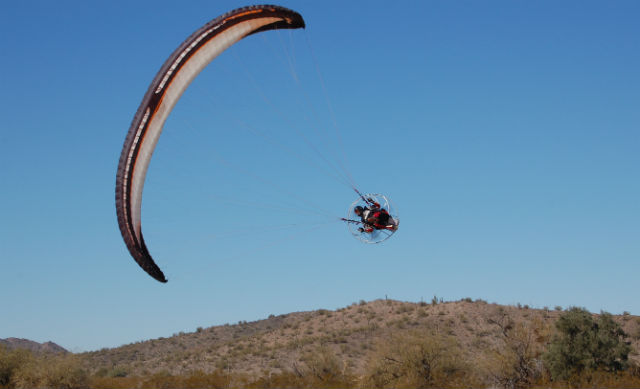At an air show such as Farnborough, where noise and speed are the hallmarks of most flying displays, the muted drone and modest headway created by the Parajet Aerial Defence Security System (PADSS) may have some difficulty in making its presence felt.
However, group brand manager Dan Wareham hopes that the novelty factor (not to mention low cost) of the wearable device – which consists of a paraglider wing and small pusher propeller strapped to the pilot’s back – will have the crowds gazing skywards.
The device, which is designed to get a soldier airborne in just a few paces once the wing has been launched, and give him an aerial view of the neighbouring terrain – the ability to look ‘over the hill’ that commanders have prized for centuries – has already attracted several orders, Wareham says.
The identities of most of the customers, which include several nations’ special forces units, cannot be disclosed. One exception is Palm Bay Police Department in Florida, while PADSS is also being trialled for tasks such as wildlife conservation in Africa.
Designed as a complement to and substitute for helicopters, one of PADSS’ selling points is its extreme compact design, Wareham says – the unit can be packed away in the back of a vehicle. Specifications include a speed of 45mph (72kh/h) and an endurance of up to 3h.
Wareham accepts there are a number of paramotor manufacturers, but says most are in the recreational flying sector, whereas Parajet is focusing on the military market. “Through our contacts we found this niche area for which we can use this machine,” he says.

The device is designed to get a soldier airborne in just a few paces once the wing has been launched
Gilo Industries
“Its main [unique selling point] is that it’s very transportable and compact, and we’re working on a number of different accessories that can be strapped on to the machine, such as a bag that can hold a military medical kit or water [purification] system,” he says. “Day or night thermal cameras can be attached, and data can be fed back directly to an operations room or to troops on the ground.”
Parajet says training to fly one of its paramotors can take as little as 10 days, with no licence needed in many countries.
Subject to validation, the company expects to fly PADSS on both the trade days and the public weekend of Farnborough 2014.
The company is one of two owned by Dorset, UK-based Gilo Industries Group that will be appearing at Farnborough. The second, Rotron, claims to be the first UK company to offer commercial-off-the-shelf (COTS) heavy fuel engines in the 20-60hp (15-45kW) range, which it will be formally launching at the show.
Rotron was established in 2008 as a specialist manufacturer of advanced rotary propulsion systems – developed from the Wankel rotary engine – for unmanned air vehicle applications. The firm already has a range of gasoline-powered engines in this power category, but its new entrants to the marketplace will run on JP8 or JP5 fuel.
Among qualities it claims for the engines are a light weight (typically 12-13kg, and said to be the lightest in the marketplace) and a compact design – important considerations for smaller UAVs that allow for more payload.
“We have a core [engine] block with ancillaries that go with it,” says Charlie Nicoll, group head of operations at Gilo.
Previously, he says, engines of this type were bespoke and built to suit a specific application, but the COTS approach simplifies production. Rotron is aiming for a target of 250h between overhauls.
“We’re working on two development contracts for customers using the COTS version,” he adds. “We’ve trialled the engine with certain customers, but at this stage it’s slightly sensitive information, given their nature.
Until now, says Rotron, the market has been unable to come up with a heavy fuel propulsion system for the medium altitude long endurance UAV sector.
This is due to the high power-to-weight ratios required – the size of the engine makes it difficult to propagate the flame and ignite heavy fuel. However, the company says it has developed patented technology to solve this problem, using advanced fuel management techniques to achieve reliability, a high power-to-weight ratio and low fuel consumption.
Parent company Gilo Industries Group was set up by aviation engineering specialist Gilo Cardozo with the aim of bringing leading-edge technologies to bear on military, commercial and recreational aviation applications.
Source: Flight International
















